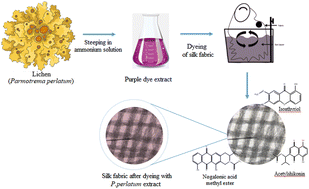Sustainable dyeing of silk using an acetylshikonin-based natural colourant from the lichen Parmotrema perlatum†
Abstract
A purple natural dye, primarily composed of acetylshikonin and methyl ester of nogalonic acid, was optimally extracted from the lichen Parmotrema perlatum by an ammonia fermentation method (AFM), using response surface methodology. A maximum yield of 41.5 mg g−1 was obtained at 60 °C after steeping the lichen in 25% ammonium solution (1 : 18) for 30 days. Furthermore, this extract was used to dye silk fabric. The dyeing conditions of silk were also optimized based on the colour strength of the dyed specimen and the percentage fixation of the dye. The best result was obtained at a pH of 4.0 at 90 °C when dyed for 60 min and carried out in a rota dyer. The optimized formulation resulted in a colour strength (K/S) of 1.652 and 94.66% of dye fixation on the fabric. The dyeing performance studies in terms of fastness and post-dyeing effect on the strength properties of the fabric, conducted on the P. perlatum-dyed silk fabric, showed comparable and satisfactory results with commercial synthetic dyes such as ISOCAN Bordeaux 25-B. The dyeing came up with a washing fastness of around 4 and a rubbing fastness of 4–5, having an overall enhancement of material strength of 6–7%. Overall, this study explores the potential of a lichen-based colourant as a novel source for sustainable dyeing of silk.



 Please wait while we load your content...
Please wait while we load your content...